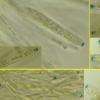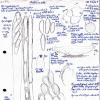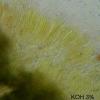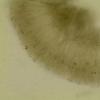
06-12-2025 00:19
 Viktorie Halasu
Viktorie Halasu
Hello, would anyone have this article, please? An

05-12-2025 17:33
 Bruno Coué
Bruno Coué
Bonjour, je serais heureux de recueillir votre avi

02-12-2025 18:59
This pair of ascos 2.5cm across were on recently b

02-12-2025 19:25
Buckwheat PeteHello, can anyone identify this hairy fungus growi

30-11-2025 12:53
 Edvin Johannesen
Edvin Johannesen
White short-stipitate apothecia found on thin twig

30-11-2025 10:47
 William Slosse
William Slosse
I recently found a collection of small Peziza sp.
Helotiales (Dermataceae) ????
Alain BRISSARD,
18-03-2012 19:21
Un peu dérouté par cette trouvaille aquatique (quelques apothécies blanches à bordure sombre sur une branche dégradée et décortiquée de feuillus au sein d'un ruisseau peu profond).
J'ai cru, dans un premier temps sur le terrain être en possession d'une espèce de Vibrissea (Decolorans??). L'examen microscopique m'a vite permis de rectifier mon diagnostic hâtif et m'a conduit à penser qu'il s'agit plutôt d'une Helotiales: Dermatacées et peut être le genre Mollisia ?????
Asques IKI+ (85-100 x 5,5-6 µm)
Spores 9-12 x 2,5 µm
Pensez-vous, au vu des clichés ci-joints, pouvoir me dire de quelle espèce il peut s'agir ou me fournir une piste.
Merci d'avance
Amitiés à tous
Hans-Otto Baral,
18-03-2012 20:50

Re : Helotiales (Dermataceae) ????
Dear Alain
I think this closely concurs with what I have as Mollisia uda.
But Andreas certainly can comment on this.
I assume you found it in autumn? Youd did not see the refractive vacuoles in the paraphyses?
At that time I did not yet know the importance to test with KOH for a yellow reaction. But from a find by Guy Garcia I assume that the species is KOH-.
Zotto
I think this closely concurs with what I have as Mollisia uda.
But Andreas certainly can comment on this.
I assume you found it in autumn? Youd did not see the refractive vacuoles in the paraphyses?
At that time I did not yet know the importance to test with KOH for a yellow reaction. But from a find by Guy Garcia I assume that the species is KOH-.
Zotto
Guy Garcia,
18-03-2012 22:36
Re : Helotiales (Dermataceae) ????
Hi Zotto,
I have two collections labelled Mollisia uda and both are KOH +++
The dates are : 24-03-2002 and 19-06-2005
Best, Guy
I have two collections labelled Mollisia uda and both are KOH +++
The dates are : 24-03-2002 and 19-06-2005
Best, Guy
Hans-Otto Baral,
18-03-2012 22:52

Re : Helotiales (Dermataceae) ????
Oh, you are right. I read only the lower part of the text to your older collection, where you stated "Les cellules marginales sont hyalines mais elles semblent se colorer faiblement dans KOH ?"
So, Alain, please test your specimen with KOH
Zotto
So, Alain, please test your specimen with KOH
Zotto
Martin Bemmann,
18-03-2012 22:59
Alain BRISSARD,
18-03-2012 23:18
Re : Helotiales (Dermataceae) ????
Hello Zotto and Guy
Merci à vous deux pour vos réponses confortant et surtout complétant mon approche.
Morgen mache ich den test mit KOH wenn möglich ist. Ich habe noch nur eine "apothecie".
Noch herzlichen Dank
Alain
Merci à vous deux pour vos réponses confortant et surtout complétant mon approche.
Morgen mache ich den test mit KOH wenn möglich ist. Ich habe noch nur eine "apothecie".
Noch herzlichen Dank
Alain
Alain BRISSARD,
18-03-2012 23:50
Re : Helotiales (Dermataceae) ????
Hi Martin
Vielen Dank für deine Antwort.Das bild ist clar gelb.
Alain
Vielen Dank für deine Antwort.Das bild ist clar gelb.
Alain
Alain BRISSARD,
19-03-2012 12:00
Re : Helotiales (Dermataceae) ????
Bonjour à tous
Voici le résultat de mon test dans KOH (20%). La réaction semble bien positive mais n'est pas toujours aussi évidente.
Il semble donc possible de dire qu'il s'agit bien de Mollisia uda ou Mollisia "pulviformis" selon Andreas Gminder. Andreas merci de confirmer.
Amitiés
Voici le résultat de mon test dans KOH (20%). La réaction semble bien positive mais n'est pas toujours aussi évidente.
Il semble donc possible de dire qu'il s'agit bien de Mollisia uda ou Mollisia "pulviformis" selon Andreas Gminder. Andreas merci de confirmer.
Amitiés
Hans-Otto Baral,
19-03-2012 12:14

Re : Helotiales (Dermataceae) ????
On your images I hardly see any yellow, but maybe it is not shown by the camera.
Did you look when you added the KOH? Though quite strong, the reaction disappears usually within a few seconds. You can also put a drop of KOH on a slide and put an apo inside, and look immediately with a handlens.
Did you look when you added the KOH? Though quite strong, the reaction disappears usually within a few seconds. You can also put a drop of KOH on a slide and put an apo inside, and look immediately with a handlens.
Alain BRISSARD,
19-03-2012 14:43
Re : Helotiales (Dermataceae) ????
Hi Zotto
Du hast recht, es gibt kein gelb nach einigen neuen test. Ich habe, wie so du hast geschreiben, gemacht. Das war immer KOH-.
Warscheinlich ist Mollisia rivularis auch möglich ?? Was denkts du den ??
Ich habe nicht mehr "apothécie".
Freundlich
Alain
Du hast recht, es gibt kein gelb nach einigen neuen test. Ich habe, wie so du hast geschreiben, gemacht. Das war immer KOH-.
Warscheinlich ist Mollisia rivularis auch möglich ?? Was denkts du den ??
Ich habe nicht mehr "apothécie".
Freundlich
Alain
Hans-Otto Baral,
19-03-2012 15:51

Re : Helotiales (Dermataceae) ????
Ja, das ist möglich! Ich kenne die Art nur von einem Trockenbeleg.
Zotto
Zotto
Alain BRISSARD,
19-03-2012 21:00
Re : Helotiales (Dermataceae) ????
Hi Zotto
Vielen dank für diese Antwort.
Also alles gut bis zu nächsten mal.
Alain
Vielen dank für diese Antwort.
Also alles gut bis zu nächsten mal.
Alain
Alain BRISSARD,
20-03-2012 18:19
Re : Helotiales (Dermataceae) ????
Selon Andreas Gminder que j'ai contacté en directe, il s'agit, par la macroscopie et la forme des spores de Mollisia "pulviniformis" (cf. sa clé) même si le test au KOH est négatif.
Pour la validation de "pulviniformis" Andreas attend des résultats susceptibles d'être fournis par la biologie moléculaire et pour être certain que M. "pulviniformis et M. rivularis appartiennent à des espèces vraiment différentes.
Amitiés à tous
Alain
Pour la validation de "pulviniformis" Andreas attend des résultats susceptibles d'être fournis par la biologie moléculaire et pour être certain que M. "pulviniformis et M. rivularis appartiennent à des espèces vraiment différentes.
Amitiés à tous
Alain
Alain BRISSARD,
20-03-2012 22:45
Re : Helotiales (Dermataceae) ????
ok Yan. Ici la discussion est ouverte à toute remarque. On cherche seulement à comprendre et dans le cas présent à tenter de situer un organisme dans la classification des Ascomycota tout en sachant que rien n'est définitif. La prudence est bien sur de règle. Merci pour votre mise au point.
Alain
Alain









